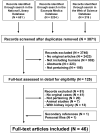Electrolyte and Acid-Base Disorders Triggered by Aminoglycoside or Colistin Therapy: A Systematic Review
- PMID: 33535401
- PMCID: PMC7912654
- DOI: 10.3390/antibiotics10020140
Electrolyte and Acid-Base Disorders Triggered by Aminoglycoside or Colistin Therapy: A Systematic Review
Abstract
Aminoglycoside or colistin therapy may alter the renal tubular function without decreasing the glomerular filtration rate. This association has never been extensively investigated. We conducted a systematic review of the literature following the Preferred Reporting Items for Systematic Reviews and Meta-Analyses recommendations. Databases searched included United States National Library of Medicine, Excerpta Medica, and Web of Science. For the final analysis, we evaluated 46 reports, published after 1960, describing 82 cases. A total of 286 electrolyte and acid-base disorders were reported. Hypomagnesemia, hypokalemia, and hypocalcemia were reported in more than three quarter of cases. Further disorders were, in decreasing order of frequency, metabolic alkalosis, hyponatremia, hypophosphatemia, hypouricemia, hypernatremia, and metabolic acidosis. Six electrolyte and acid-base disorders were reported in seven cases, five in 12 cases, four in 16 cases, three in 31 cases, two in 11 cases, and one in five cases. Laboratory features consistent with a loop of Henle/distal tubular dysfunction were noted in 56 (68%), with a proximal tubular dysfunction in three (3.7%), and with a mixed dysfunction in five (6.1%) cases. The laboratory abnormality was unclassified in the remaining 18 (22%) cases. Treatment with aminoglycosides or colistin may trigger a proximal tubular or, more frequently, a loop of Henle/distal tubular dysfunction.
Keywords: aminoglycosides; colistin; dyselectrolytemia; hypocalcemia; hypokalemia; hypomagnesemia.
Conflict of interest statement
The authors declare no conflict of interest.
Figures
Similar articles
-
Kidney Tubular Damage Secondary to Deferasirox: Systematic Literature Review.Children (Basel). 2021 Dec 1;8(12):1104. doi: 10.3390/children8121104. Children (Basel). 2021. PMID: 34943300 Free PMC article. Review.
-
Hypomagnesemia in a department of internal medicine.Magnes Res. 2012 Dec;25(4):149-58. doi: 10.1684/mrh.2012.0325. Magnes Res. 2012. PMID: 23261516
-
Electrolyte and acid-base disorders in cancer patients and its impact on clinical outcomes: evidence from a real-world study in China.Ren Fail. 2020 Nov;42(1):234-243. doi: 10.1080/0886022X.2020.1735417. Ren Fail. 2020. PMID: 32138574 Free PMC article.
-
Hypomagnesemic hypokalemia and hypocalcemia: clinical and laboratory characteristics.Miner Electrolyte Metab. 1997;23(2):105-12. Miner Electrolyte Metab. 1997. PMID: 9252977
-
Fluid, electrolyte and acid-base disorders associated with antibiotic therapy.Nat Rev Nephrol. 2009 Apr;5(4):193-202. doi: 10.1038/nrneph.2009.17. Nat Rev Nephrol. 2009. PMID: 19322184 Review.
Cited by
-
The spectrum of hypophosphatemia in internal medicine: lessons from a Greek population study.J Endocrinol Invest. 2025 Jun;48(6):1473-1481. doi: 10.1007/s40618-025-02558-9. Epub 2025 Apr 4. J Endocrinol Invest. 2025. PMID: 40183914 Free PMC article.
-
Kidney tubular injury induced by valproic acid: systematic literature review.Pediatr Nephrol. 2023 Jun;38(6):1725-1731. doi: 10.1007/s00467-022-05869-8. Epub 2023 Jan 16. Pediatr Nephrol. 2023. PMID: 36645492 Free PMC article.
-
Renal Function in Patients with Cystic Fibrosis: A Single-Center Study.Int J Environ Res Public Health. 2022 Apr 29;19(9):5454. doi: 10.3390/ijerph19095454. Int J Environ Res Public Health. 2022. PMID: 35564849 Free PMC article.
-
Incidence, Risk Factors and Prognosis of Hypokalaemia in Patients with Normokalaemia at Hospital Admission.Indian J Endocrinol Metab. 2023 Nov-Dec;27(6):537-543. doi: 10.4103/ijem.ijem_159_23. Epub 2024 Jan 11. Indian J Endocrinol Metab. 2023. PMID: 38371186 Free PMC article.
-
Hypernatremia During Intravenous Treatment With Fosfomycin: A Retrospective Medical Record Review Study and an Analysis of Spontaneous Reports in the EudraVigilance Database.Front Pharmacol. 2022 Mar 29;13:844122. doi: 10.3389/fphar.2022.844122. eCollection 2022. Front Pharmacol. 2022. PMID: 35422698 Free PMC article.
References
-
- Werner C.A., Tompsett R., Muschenheim C., McDermott W. The toxicity of viomycin in humans. Am. Rev. Tuberc. 1951;63:49–61. - PubMed
Publication types
LinkOut - more resources
Full Text Sources
Other Literature Sources


